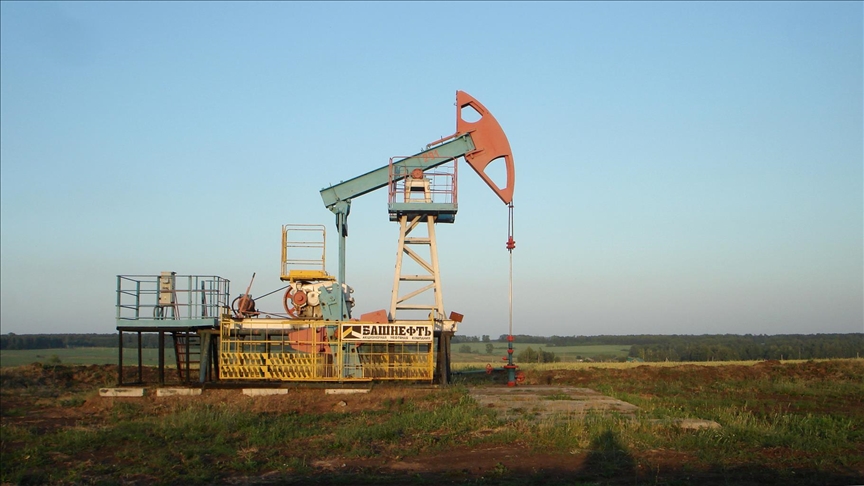LONDON
Russia’s crude oil and diesel exports are at higher volumes than in the pre-war period with the emergence of new export destinations, particularly China and India, for crude exports and a good range of buyers for diesel exports, according to Vortexa data compiled by Anadolu.
Russia’s crude oil exports plummeted to the lowest of 2.28 million barrels a day in May 2019 but hit a record high of 4.02 million barrels a day in July 2020, data comprising Russia’s crude oil exports between January 2016 and June 2023 shows.
Russia’s crude oil exports last year before the war, between January 2021 and January 2022, reached between 2.75 million and 3.30 million barrels a day.
in February 2022 when Russia started its war in Ukraine, crude oil exports totaled 3.17 million barrels per day.
In a bid to target Russia’s export revenues, Western countries tried to shift away from exporting crude oil and oil products from Russia.
The European Union (EU) and G7 countries banned seaborne crude exports from Russia by Dec. 5 last year, imposing a price cap of $60 per barrel.
As a result, Russia sought new export destinations for its oil exports, with China and India emerging as the largest importers of cheaper Russian petroleum, resulting in virtually no change in Russia’s crude export volumes but at much higher levels.
Russia’s crude export volumes in the post-war period only dropped below 3 million barrels a day in July and December last year.
The country exported 3.29 million barrels a day this February and 3.51 million barrels a day in March, while exports hit 3.71 million barrels a day in April this year and 3.64 million barrels a day in May.
June this year saw Russia’s crude exports surpass pre-war levels at 3.49 million barrels a day.
“Crude exports from Russia have increased as pipeline exports from the northern leg of the Druzhba pipeline have been rerouted to seaborne exports as of late last year,” David Wech, Vortexa’s chief economist, told Anadolu.
The pipeline is one of the biggest crude oil pipeline networks in the world, with a total length of 5,500 kilometers, including all its branches. The pipeline starts in Almetyevsk, Russia, where pipelines carrying crude oil from Siberia, the Urals and the Caspian Sea converge.
The pipeline splits into a northern and a southern leg, with the northern leg continuing via Belarus and Poland to Germany and the southern branch running through Ukraine to Slovakia and Hungary.
The pipeline’s capacity is between 1.2 million and 1.4 million barrels per day, with the potential to increase to 2 million barrels per day.
“Meanwhile, much more crude is being declared as transit crude, with Kazakhstan Export Blend Crude Oil (KEBCO) barrels being attributed to its Kazakh origin, allowing the avoidance of all sanctions. Technically, these barrels are the same as Urals and have always been. They just reflect the share of Kazakh transit crude in the Urals blend,” he noted.
The transit crude oil exports stood at 1.36 million and 1.49 million barrels a day in January and February 2022, respectively. These volumes hit their highest level of 1.84 million barrels a day in March 2023 and remained at 1.61 million barrels a day in June 2023.
Diesel exports at near-record levels
Wech explained that diesel exports are “much higher as Russia makes every effort to maximize those flows due to their high value and the much higher premium product price cap of $100 per barrel”.
Europe has imposed a ban on Russian diesel and other refined oil products, taking effect on Feb. 5, 2023.
“Diesel is the only Russian export flow, except for liquefied natural gas, which is exempt from European sanctions, where Russia enjoys a broad pool of buyers. Crude and other product exports are dependent on very few buyers, led by China and India,” Wech said.
Russia’s diesel exports remained mostly below 1 million barrels a day during the period the data covers, but the volumes reached 1.1 million barrels a day in February 2022, when the war started.
The following months saw Russian diesel exports at a level of 800,000 barrels a day until recovering to 1 million barrels a day in November 2022.
The highest diesel export volumes were recorded in March 2023 at 1.3 million barrels a day. They dropped to 1.19 million and 875,000 barrels a day in April 2023 and May 2023, respectively.
However, export volumes rebounded to 1.27 million barrels a day in June 2023, exceeding levels recorded in the pre-war period.
Wech also said other product exports were down compared to pre-war levels, but exports recovered slightly from a strong downturn right after the war started.
Russia’s crude exports show seasonal decline over summer months
According to Wech, Russian crude oil exports in general record seasonal declines over the summer months due to higher domestic demand from higher refinery runs after the spring maintenance season as well as oil field maintenance.
Consequently, Wech considers that the latest announcement of Russia’s crude export cuts “has to be taken with a pinch of salt, similarly to the announcements of the 500,000 barrel a day production cuts as of March”, which he said were not really implemented according to market sources.
Russia said Monday it would voluntarily reduce its oil supply by 500,000 barrels per day in August by cutting its exports to global markets by that amount “as part of the effort to ensure the oil market remains balanced.”
“Russian crude exports do decline anyway seasonally over the summer months, so it looks like Russia is trying to sell this seasonal decline in exports as an additional, voluntary cut,” he concluded.

